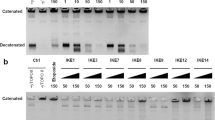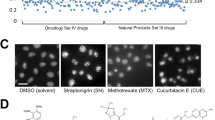Abstract
The centromeres of budding yeasts contain specific and essential DNA sequences, in contrast to the regional heterochromatic centromeres found in higher organisms. Small molecules that perturb centromere function in budding yeast could be valuable candidates for identifying yeast-specific growth inhibitors. A combination of two in vivo assays, one based on transcription blockade of a reporter gene by the centromeric DNA-protein complex, the other on a test for mitotic minichromosome stability, was used to identify small molecules that affect the process of chromosome segregation. One compound, here named incentrom A, leads to a minichromosome loss phenotype, and is cytotoxic to the budding yeast Saccharomyces cerevisiae. Furthermore, whereas cells carrying a conditional mutation in a gene for an essential kinetochore protein, skp1-4 , are hypersensitive to incentrom A, cells that overexpress the SKP1 gene are resistant to the compound. Incentrom A also results in mitotic loss of a centromere-bearing plasmid, and inhibits the growth of the pathogenic yeast Candida glabrata. Incentrom A will therefore be a useful tool for studying the molecular basis of yeast chromosome segregation and could form the basis for the development of novel antifungal drugs.







Similar content being viewed by others
References
Andreeva NI, Mashkovsky MD, Golovina SM, Gorkin VZ (1992) Novel antidepressant drug tetrindole (2, 3, 3a, 4, 5, 6-hexahydro-8-cyclohexyl-1H-pyrazino [3, 2, 1-j, k] carbazole. 1. Pharmacological study of the influence on central nervous system. Chem Pharm J 26:17–23
Centers for Disease Control and Prevention (2001) Candidiasis information. Division of bacterial and mycotic diseases
Cheeseman IM, Drubin DG, Barnes G (2002) Simple centromere, complex kinetochore: linking spindle microtubules and centromeric DNA in budding yeast. J Cell Biol 157:199-203
Clarke L, Carbon J (1980) Isolation of a yeast centromere and construction of functional small circular chromosomes. Nature 287:504–509
Connelly C, Hieter P (1996) Budding yeast SKP1 encodes an evolutionarily conserved kinetochore protein required for cell cycle progression. Cell 86:275–285
Cottarel G, Shero JH, Hieter P, Hegemann JH (1989) A 125 base-pair CEN6 DNA fragment is sufficient for complete meiotic and mitotic centromere functions in Saccharomyces cerevisiae. Mol Cell Biol 9:3342–3349
Crews CM, Mohan R (2000) Small-molecule inhibitors of the cell cycle. Curr Opin Chem Biol 4:47–53
Fidel PL, Vazquez JA, Sobel JD (1999) Candida glabrata: review of epidemiology, pathogenesis, and clinical disease with comparison to C. albicans. Clin Microbiol Rev 12:80–96
Fonzi WA, Irwin MY (1993) Isogenic strain construction and gene mapping in Candida albicans. Genetics 134:717–728
Gardner RD, Poddar A, Yellman C, Tavormina PA, Monteagudo MC, Burke DJ (2001) The spindle checkpoint of the yeast Saccharomyces cerevisiae requires kinetochore function and maps to the CBF3 domain. Genetics 157:1493–1502
Hanic-Joyce PJ, Joyce PBM (1998) A high-copy-number ADE2 -bearing plasmid for transformation of Candida glabrata. Gene 211:395–400
Hegemann JH, Shero JH, Cottarel G, Philippsen P, Hieter P (1988) Mutational analysis of centromere DNA from chromosome VI of Saccharomyces cerevisiae. Mol Cell Biol 8:2523–2535
Hieter P, Mann C, Snyder M, Davis RW (1985) Mitotic stability of yeast chromosomes: a colony color assay that measures nondisjunction and chromosome loss. Cell 40:381–392
Hoyt MA, Totis L, Roberts BT (1991) S. cerevisiae genes required for cell cycle arrest in response to loss of microtubule function. Cell 66:507–517
Iwasaki S (1993) Antimitotic agents: chemistry and recognition of tubulin molecule. Med Res Rev 13:183–198
Kerscher O, Crotti LB, Basrai MA (2003) Recognizing chromosomes in trouble: association of the spindle checkpoint protein Bub3p with altered kinetochores and a unique defective centromere. Mol Cell Biol 23:6406–6418
Kitada K, Yamaguchi E, Arisawa M (1995) Cloning of the Candida glabrata TRP1 and HIS3 genes, and construction of their disruptant strains by sequential integrative transformation. Gene 165:203–206
Kitada K, Yamaguchi E, Arisawa M (1996) Isolation of Candida glabrata centromere and its use in construction of plasmid vectors. Gene 175:105–108
Kitada K, Yamaguchi E, Hamada K, Arisawa M (1997) Structural analysis of a Candida glabrata centromere and its functional homology to the Saccharomyces cerevisiae centromere. Curr Genet 31:122–127
Lechner J, Carbon J (1991) A 240 kd multisubunit protein complex, CBF3, is a major component of the budding yeast centromere. Cell 64:717–725
Li R, Murray AW (1991) Feedback control of mitosis in budding yeast. Cell 66:519–531
Mayer TU, Kapoor TM, Haggarty SJ, King RW, Schreiber SL, Mitchison TJ (1999) Small molecule inhibitor of mitotic spindle bipolarity identified in a phenotype-based screen. Science 286:971–974
McAinsh AD, Tytell JD, Sorger PK (2003) Structure, function, and regulation of budding yeast kinetochores. Annu Rev Cell Dev Biol 19:519–539
McGrew J, Diehl B, Fitzgerald-Hayes M (1986) Single base-pair mutations in centromere element III cause aberrant chromosome segregation in Saccharomyces cerevisiae. Mol Cell Biol 6:530–538
Medvedev AE, Kirkel AA, Kamyshanskaya NS, Moskvitina TA, Axenova LN, Gorkin VZ, Andreeva NI, Golovina SM, Mashkovsky MD (1994) Monoamine oxidase inhibition by novel antidepressant tetrindole. Biochem Pharm 47:303–308
Murphy TD, Karpen GH (1998) Centromeres take flight: α-satellite and quest for the human centromere. Cell 93:317–320
Ng R, Carbon J (1987) Mutational and in vitro protein-binding studies on centromere DNA from Saccharomyces cerevisiae. Mol Cell Biol 7:4522–4534
Ng R, Cumberledge S, Carbon J (1986) Structure and function of centromeres. In: Hicks J (ed) Yeast cell biology. Alan R. Liss, New York, pp 225–239
Perier F, Carbon J (1992) A colony color assay for Saccharomyces cerevisiae mutants defective in kinetochore structure and function. Genetics 132:39–51
Pfaller MA, Messer SA, Hollis RJ, Jones RN, Doern GV, Brandt ME, Hajjeh RA (1999) Trends in species distribution and susceptibility to fluconazole among blood stream isolates of Candida species in the United States. Diagn Microbiol Infect Dis 33:217–222
Pluta AF, Mackay AM, Ainsztein AM, Goldberg IG, Earnshaw WC (1995) The centromere: hub of chromosome activities. Science 270:1591–1594
Schreiber SL (2003) The small-molecule approach to biology. Chem Eng News 81:51–61
Spencer F, Gerring SL, Connelly C, Hieter P (1990) Mitotic chromosome transmission fidelity mutants in Saccharomyces cerevisiae. Genetics 124:237–249
West RW, Yocum RR, Ptashne M (1984) Saccharomyces cerevisiae GAL1 - GAL10 divergent promoter region: location and function of the upstream activating sequence UASG. Mol Cell Biol 4:2467–2478
Zhou P, Szczypka MS, Young R, Thiele DJ (1994) A system for gene cloning and manipulation in the yeast Candida glabrata. Gene 142:135–140
Acknowledgements
I am grateful to John Carbon for critical reading of the manuscript. I thank H. Roe and E. George for technical assistance, past and present members of the Carbon and Clarke laboratories for many discussions, and P. Hieter, C. Dougherty, A. Murray, D. Gebow and T. Stoyan for providing yeast strains and/or plasmids. I thank D. Gebow for sharing useful ideas and S. Shin for obtaining the mass spectrum of incentrom A. A portion of this work was carried out in John Carbon’s laboratory at the University of California, Santa Barbara, and was supported by NIH Grant CA-11034. This work was also supported by the Brain Korea 21 Project, the KISTEP NRL Program (Grant No. 2000-N-NL-01-C-210), and the KIST Functional Proteomics Center.
Author information
Authors and Affiliations
Corresponding author
Additional information
Communicated by C. P. Hollenberg
Rights and permissions
About this article
Cite this article
Yoon, HJ. A novel small-molecule inhibitor of the chromosome segregation process in yeast. Mol Genet Genomics 271, 490–498 (2004). https://doi.org/10.1007/s00438-004-1000-1
Received:
Accepted:
Published:
Issue Date:
DOI: https://doi.org/10.1007/s00438-004-1000-1




